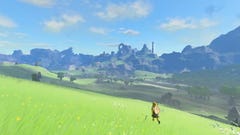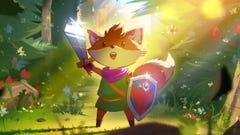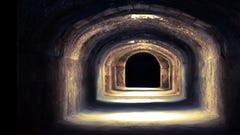State of the Game: Fallout 76 - wandering the wastes once more, with meaning
Brave nuke world.
As the vault door rolls open to reveal another golden Appalachian sunset, I pause for a moment, and wonder what the West Virginian wasteland could possibly have in store for me this time. When I was last here, a little over four years ago, the answer was: not much. At launch, Fallout 76 cast players into a lifeless world, and tasked them with making their own fun. It was a place populated by ghosts and audio tapes. Like many at the time, I gave it a fair go for several weeks, yet found nothing that could compel me to stick around. I shelved my level 23 character, and left it at that.
But this time, as I descend the Vault-Tec steps, I immediately spot evidence of some rather dramatic changes. Two human NPCs are here, and they have a quest for me. Perhaps, I think, this is going to be a very different experience after all.
Fallout 76, of course, had a famously messy launch. Alongside some pretty damning review scores, there were problems with canvas/nylon bags, and the game's development process was reportedly blighted by poor management and mandatory crunch. In the years since then, however, there have been concerted efforts to fix the game's problems. Bethesda has released a slew of updates in an attempt to breathe new life into the game, and the introduction of human NPCs has been just one entry in a long line of improvements. Thanks in part to these additions (and the game's release on Xbox Game Pass and PlayStation Plus Extra), Fallout 76 is currently experiencing something of a revival, with 13.5m players dipping into the game in 2022. For this reason, now seems as good a time as any to check on its progress. That, and I keep seeing posts about how the game 'is good now'. Time to test the theory.
The two women on the hill point me towards a dive bar called The Wayward. This is where things really start to look promising, as I am given a main questline with dialogue options, skill checks, multiple endings and a sense of humour. It seems silly to get so excited about this, but I am. Fallout just doesn't feel Fallout without its human communities: groups of oddballs and thugs trying their best to forge new lives in the ruins of nuclear disaster. Fallout is a grim franchise, but it's always had an air of goofiness to it, and the new quests have somewhat restored this balance. The Wayward quest requires me to rescue a robot, use her head to zap enemies, then convince a jobsworth Mister Handy to give her a new body. Another quest sees me investigate a frat party and drink a suspicious beverage that teleports me to a Mad Hatter's tea party. It's these sort of ludicrous interactions that motivate me to keep exploring.

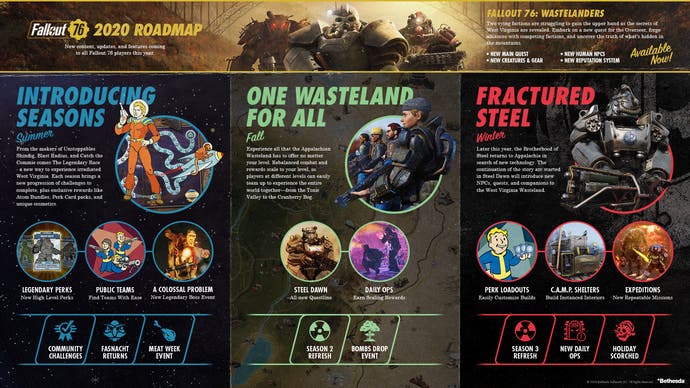

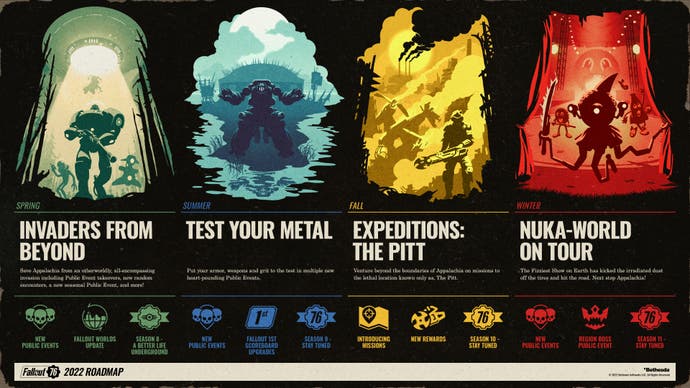
The impact of adding humans to Fallout 76 really cannot be understated. Everything feels so much more vibrant now that communities have moved into Appalachia's towns. I've always had a soft spot for Fallout 76's environmental design - with its bizarre structures placed atop rolling hills to invite exploration - and I now know that when I reach these buildings, there's likely to be something (or someone) there.
The new main questline has another function, which is to push me around the map. Fallout 76 previously felt a bit unstructured. You could follow the Overseer's logs, sure, but this quickly became so dull that you would simply wander off in search of something more interesting. The Wayward questline has tangible consequences, allowing you to pick the outcome and side with a faction. For this reason I'm willing to follow it around the map, side-questing as I move into different areas. As a storyline, it's probably not going to win a Pulitzer Prize, but it's impressive that a narrative team has been able to retrofit all of this in, and make it work. Importantly, it's enough to keep me engaged and moving through Fallout 76's world.
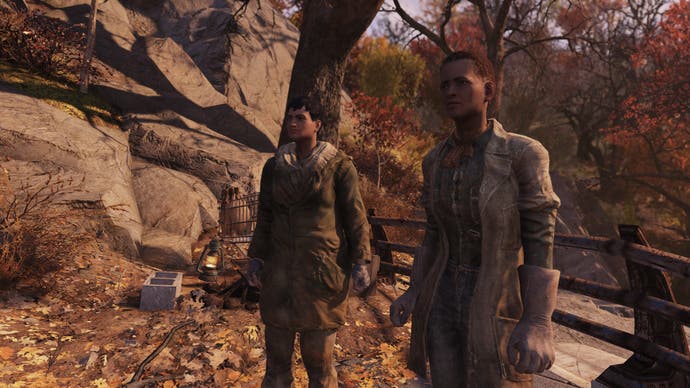
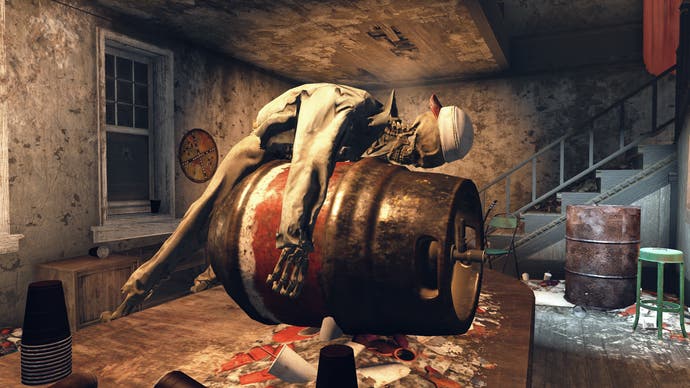
In my first few hours, I quietly plug away at these low-level quests, glancing nervously at my Pip-Boy. I frequently spot level 400, 800, even level 1800 players shifting around in the bottom-right corner of the map, launching nuclear weapons and walking through the fallout. What in hell is going on over there? It's all a little terrifying, and feeling rather out of my depth, I initially avoid contact with other players. But as my confidence grows and I become more curious, I start poking my head into player camps. I find that many of them are now designed entirely around their vending stalls, with bright neon signs to attract customers.
Multiplayer was the whole point of Fallout 76, of course, but the launch version was strangely devoid of reasons to interact with anyone. You could drop items to help other people out, or engage in mostly pointless PvP battles, but it didn't feel like the game had any systems in place to encourage meaningful interaction. That's changed pretty dramatically now, and the player vending machines are at the heart of this. The vending machines provide a reason to visit player camps, and for that reason, players tend to make more of an effort to design their camps for visitors. Buying from player vendors can be particularly useful for those just starting out, who need to catch up on collecting crafting plans. And it provides an entirely new way to play the game - I've seen some players on Reddit explain how they will visit player camps to find bargains, then mark up the prices and re-sell them for profit. Like a thrift shop in Camden.
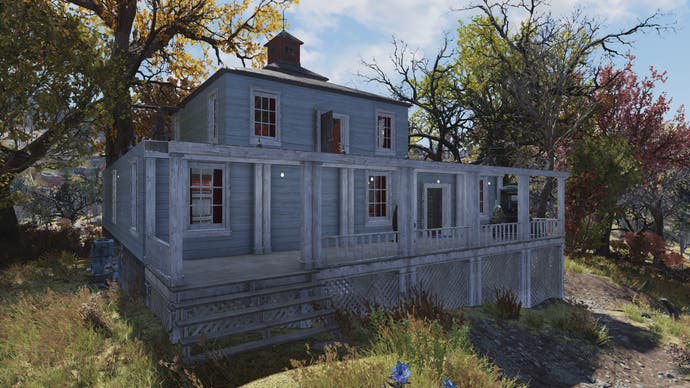

Beyond player vendors, another significant difference here is the public teams system, introduced in 2020. You can quickly join a team and be matched up with three other players, then receive benefits such as boosts to your stats and shared perks. Travelling to distant areas in Fallout 76 can be pretty pricey for newcomers - the action normally requires caps - but in a team you can travel to your teammates (and their camps) for free. This encourages you to bump into each other, or at least, visit each other's camps to buy items. More importantly, the teams are able to create an instant connection between players.

Fallout 76's community has a reputation for being friendly, and I soon find out that this is true, and then some. I help one player defend their workshop from enemies, then watch in amazement as they drop a pile of stimpacks and crafting plans on the floor for me. Later, a level 400 teammate visits my camp, and buys some of my tatty low-level items. These are things that they surely don't need, and purchase just to help me get my business off the ground. Inspired by their kindness, I soon find myself hiding in the bushes outside Vault 76, having deposited a pile of medicine on the ground to surprise a fledgling level-one player. Unusually for a multiplayer game, there's a true spirit of kindness to be found in this community. As I've seen one player explain: "there are already enough things that want to kill you out there."
As I complete the main Wayward questline and wrap up several of the early quests, a sense of deja vu starts to creep in. This sensation of grinding hard, and not making a whole lot of progress, seems eerily familiar. Many of the quests start asking me to fetch things from distant corners of the map. The rate of progress feels slow - designed to stretch out the content over potentially hundreds of hours of playtime - and while that may appeal to some, I find it creates a diluted and less compelling experience.
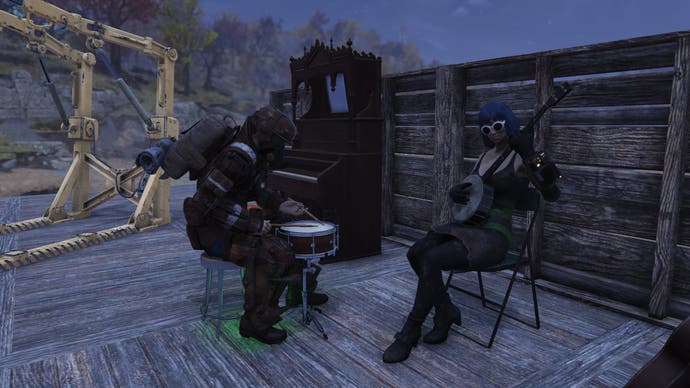
While some improvements have been made to inventory management - increases to your camp's stash limit being one major example - the carry limit means that adventures through the wasteland are still, at least initially, quite short. You are required to pick up hundreds of items for scrap, but the game also won't let you pick up much at once. So instead of immediately venturing over a tempting horizon, you first have to trudge back to a vendor or stash box. I find myself spending so much time rifling through junk and in-game menus that I sometimes forget to look up and take a breather; to admire the wonderful scenery around me. On top of all this, combat remains fairly basic: enemies will simply run at you, and most events are essentially about mowing down large numbers of enemies.
The camp building process is another real wake-up call, reminding me that many of Fallout 76's underlying problems remain. Getting pieces to snap together can be tricky, while building on bumpy terrain can make things difficult. It is nigh impossible to build anything that doesn't resemble a box. Fallout 76 is very picky about where you can place things, and seems to have strange hidden building rules. I successfully snap a doorway to some stairs using the basic wooden walls, for instance, but attempting the same with 'log cabin' build pieces simply doesn't work. After spending 20 hours in the wasteland, I take a step back and admire my camp. It looks truly awful. I imagine how long it will take to build something nice, and sink into despair. There's still a slight feeling of being nudged towards Fallout 1st and the Atom Shop.

And so, for these reasons, I find myself once again roaming the wastes, feeling lost and unmotivated, much like I did at the game's launch. A long and grindy road stretches out before me, one that I lack the desire or energy to venture down. Then something changes.
I realise that I've inadvertently designed my character as the wasteland version of Vogue editor-in-chief Anna Wintour. And this gives me an idea. I decide to set up my camp as a 'designer' clothes store. This fills me with new purpose, and suddenly, I find myself bounding through the wasteland in search of items of clothing. This role-playing element of Fallout 76 is perhaps where the game still shines brightest. Over the years we've seen Deathclaw Mazes, dedicated roleplaying communities, and even Shakespeare performances in-game: all brilliant examples of the ways players have used the tools given to them to create something unexpected. Perhaps Fallout 76 is truly at its best when you make it your own.

So where does that leave Fallout 76 in the year 2023? There's no doubt that it's been significantly improved, with the human NPCs, quests, and rejigged player interactions all giving players a reason to stick around. Aside from a couple of pesky stutters and freezes around player camps, most of the performance issues seen at launch have been sorted. Appalachia no longer feels like a graveyard. Yet all these home improvements can only do so much when the house is built on shaky foundations. Problems with grind, inventory management and unwieldy systems remain, meaning that Fallout 76 definitely remains a flawed game. But it's one that can now keep you entertained for some time - particularly if you connect with its kind, dedicated community. And if you find a way to put a creative spin on your adventures through the post-apocalypse... well. See you in a few hundred hours.
This piece is part of our State of the Game series, where we check in on some of the biggest service games running to see how they're getting on. You can find plenty more pieces like it in our State of the Game hub.


